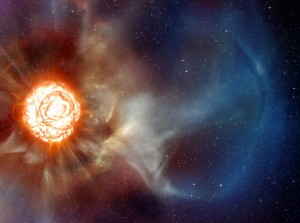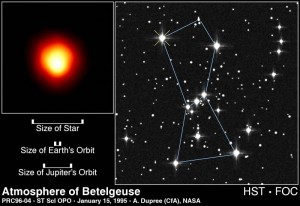By Kiranga,
I was startled to read that that much under-appreciated red supergiant of the skies, the star named scientifically as Alpha Orionis and commonly known as Betelgeuse, is finally using up it’s energy for nuclear fusion, the process that keeps all stars burning, changing the fuel of mostly hydrogen into helium and to a lesser extent helium into the subsequent higher elements. That Betelgeuse is about to undergo a supernova — a final explosion after reaching the critical energy level — shortly. Shortly in this case is of course a relative term, and in astronomical matters, a million years could be termed “shortly”.
I first came to know about Betelgeuse in the early nineties at the Tambaza library through the psychedellic Douglas Adam’s “The Hitchhikers Guide To The Galaxy” (HHGTTG). As much as it was not curriculum material, it was worth it. And this was before the movie, or me knowing anything about it’s cult-like following. I indulged myself in anything galactic, learning much about nuclear fusion at the heart of star, the formation of the higher than helium elements, going back all the way to the inflation theory right after the big bang, and that singularity that is supposed to have started it all. All along, Betelgeuse being a nearby super giant, featured frequently in these personal indulgences.

The etymology of the name Betelgeuse is rooted in Arabic, depicting the golden era in Arabic astronomy. The star was scientifically catalogued at least from 1420 at the great observatory of Samarkand in present day Uzbekistan, by the Persian prince Ulugh Beg. Even eighteen centuries earlier, Ptolemy is reported to have recorded in his Magnum Opus “Almagest”. When Edmond Halley — of Halley’s comet fame — was investigating the relative motions of the star, he was able to find the Ptolemaic charts to be of great help. And amongst all the stars, Betelgeuse, with it’s combination of size and proximity, proved exceedingly helpful.
Supernovae, those final explosions when stars uses up their fuel down to a critical mass, are nothing new, not even to human records. The Chinese recorded many, 75 from 532 BC to 1064 AD. The most famous being on July 04 1054 when they noticed a new star in Taurus. As recent as the age of Tycho Brahe and Copernicus there were several occassions to observe them. What is special about the Betelgeuse supernovae, should it occur in our lifetime, is the sheer size and proximity (astronomical of course) of this giant.
 The tricky part about measuring astronomical data such as the dying of Betelgeuse, is that Einstein’s relativity manifests itself pronouncedly with the astronomical distances. For example, it takes light from the sun about 8 minutes to reach the earth. That means, if somebody was to instantly turn off the sun, people on the day side of the earth will not know about that for another eight minutes. Now try to put Betelgeuse in the same position, the difference being instead of the eight minutes light from the sun takes to reach the earth, substitute 1,300 years (Betelgeuse is about 1,300 light years from earth). For all practical purposes, it could have gone supernovae around AD 700, just before the crusades, and Douglas Adams wouldn’t be the wiser.
The tricky part about measuring astronomical data such as the dying of Betelgeuse, is that Einstein’s relativity manifests itself pronouncedly with the astronomical distances. For example, it takes light from the sun about 8 minutes to reach the earth. That means, if somebody was to instantly turn off the sun, people on the day side of the earth will not know about that for another eight minutes. Now try to put Betelgeuse in the same position, the difference being instead of the eight minutes light from the sun takes to reach the earth, substitute 1,300 years (Betelgeuse is about 1,300 light years from earth). For all practical purposes, it could have gone supernovae around AD 700, just before the crusades, and Douglas Adams wouldn’t be the wiser.
The mechanical Newtonian worldview, that there is one central clock that all time in the universe is following was shatterd — well, more like upgraded — by the discovery of Einstein’s relativity. So time itself is relative. The farther away you are from an object in space, the farther this object’s information has to travel to reach you, and as a result, when it reaches you, the information is no longer current.
Betelgeuse is a relatively young star, at 10 million years it is a baby in astronomical years. With the earth at an estimated 4.5 billion years, Betelgeuse is only 0.22% of the age of the earth. If it’s super-giant size (about 1,000 times larger than our sun) was something to brag about, it is also the cause of it’s early demise. Generally, supergiants, because of their massive interiors, tend to burn their energies at a faster rate. Earthlings should be thankful that our local star, also known as the sun, is a mere yellow dwarf. This means it burns its hydrogen and helium in a rather slow nuclear fusion process, a process that has been going for about 5 billion years, and projected to continue at this rate for another 5 billion years.
So we do have time. That is if we do not annihilate ourselves with man-made nuclear warfare and other extinction-level event type of mayhem. Presumably we should be able to colonize other star systems, but that is more Science Fiction than a Hugo award event right now.


Nice post “Mzee”! Ulikuwa Tambaza wakati nchi inajadili kujitosa kwenye mfumo wa vyama vingi? 🙂
It put things into perspective. This discussion (off facebook) might interest you:
What struck me was the hype of the possibility of seing two suns, even momentarily. (see here: http://bit.ly/dH7n4A)
Is that even possible? Huo mwanga na effects za radiation zitatuacha salama if any of this were to happen, say, kesho?
Ulipozungumzia the cult like following of HHGTTG umenikumbusha when the last of the prequel trilogy of Star Wars came out, zaidi ya watu 1000 kwenye the premier screen walikuwa in Star Wars costumes! Bado kidogo nisijue kama niko cinema au kwenye fancy dress party.
LOL @ Star Wars costumes! Na wewe Hyperkei ‘ulikuwepo’ wakati ile Star Wars inatoka?
Hiyo ya “majuha” mawili noma. Moja tu linatupa shida…
@SN, kwani unafikiri ndio nilikuwa kwenye tukio lenyewe basi! Balaa lote hilo Cinema tu!Watu wana mpaka masks na yale maflowing jackets na glow in the dark wands isipokuwa Mswahili mmoja, kafuja!
Lakini ukifikiria hiyo yote inatuonyesha ile culture ya kuthamini creativity. Nafikiri nasi Watanzania tunatakiwa kufika huko. Japo kuwa kabla ya kufika kwenye kuthamini tunatakiwa kulea culture ya watu kuwa wabunifu zaidi. We lack that sijui ndio kutokana na mfumo wa elimu au wa kijamii?
Ok, almanusura nianze kukupa “shikamoo”!
Mtu anayehitaji maendeleo na mtu anayetamani maendeleo (yao binafsi na watu wanaomzunguka) wanatofautiana fikra. Mmoja anafikiria miaka 10, 20, 30 mpaka 50 mbele, mwingine ni mvivu, hata kukaa kitako na kujipanga kwa ajili ya mambo anayotaka atimize baada ya miaka miwili tu hawezi au hawezeshwi…
Mfumo wa elimu na jamii zinazotulea zinachangia. Watoto wadadisi wakitaka kuvunja ‘rimonti’ ili waone kilichopo ndani, tunawapiga makonzi. Halafu, unataka mtoto huyo huyo baadae awe mbunifu.
Ukiangalia, wale waliokomaa na udadisi wao ndio hivyo, wanakuja kutuandikia makala kama hizi. We unadhani Watanzania wangapi wanajisomea tu kama Kiranga (wakati yuko Tambaza) — kama hobby?
Ni mjadala mrefu, lakini kila kitu kikitokea (lawama kwa walio juu na walio chini), tunarudi kwenye hilo swali lako. Ungedhani labda watu wangeamka (sio kutegemea NGOs tu) na kulivalia njuga hilo suala.
Jenerali Ulimwengu amesema haya wiki mbili zilizopita kwenye Kongamano la Katiba; kuwa tunapenda vitu rahisi-rahisi, njia za mkato, hatupendi kujisomea, tunaogopa vitabu, mfumo wa elimu ambao haumfundishi mtu kuhoji na kujenga fikra zake mwenyewe… Kwa kifupi alisema tuanze kujiangalia wenyewe mmoja mmoja, jamii, halafu baada ya hapo ndio tutengeneze Katiba Mpya (ambayo inahitajika).
Unadhani watu walijadili hayo aliyosema? La hasha. Mijadala ilikuwa inahusu “Prof. Shivji amuumbua Mnyika” na “Wakuu wa Wilaya ni mashemeji wa walioko huko juu”! Sasa, unabaki mdomo wazi tu… Utafanya nini?
Tatizo liko kwenye malezi. Wazazi hawalei kwa kukuza vipaji wala uwezo wa kufikiri na kujenga hoja kwa watoto.
Wangapi wanafika kufikia utu uzima hawajawahi kuwa na discussion ya jambo lolote na wazazi wao let alone kupingana nao kwa hoja.
Vijana wengi mazungumzo na wazazi wao are made up of Q & A with yes, no, haya, nimesikia kind of answers.
Matokeo yake vijana hawawezi kujenga hoja, na hata wakiwa na hoja yenye nguvu uwasilishaji unakuwa mbovu, hawajui kufikisha ujumbe bila ya kuwafanya wanaepingana nao kwa hoja kujihisi inferior.